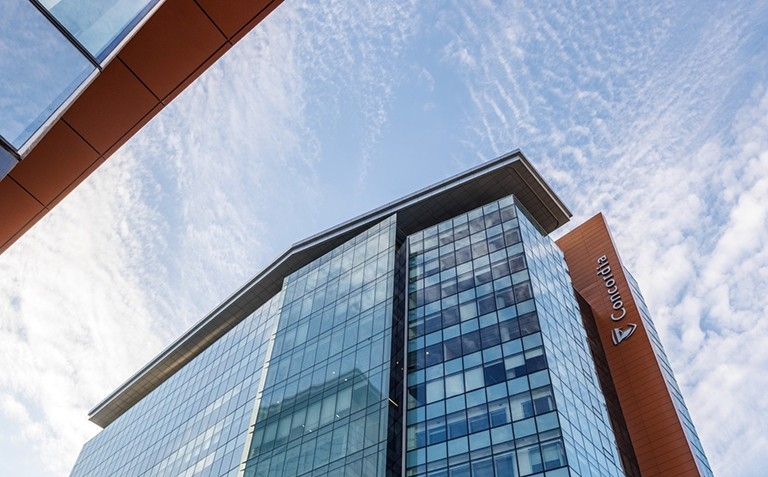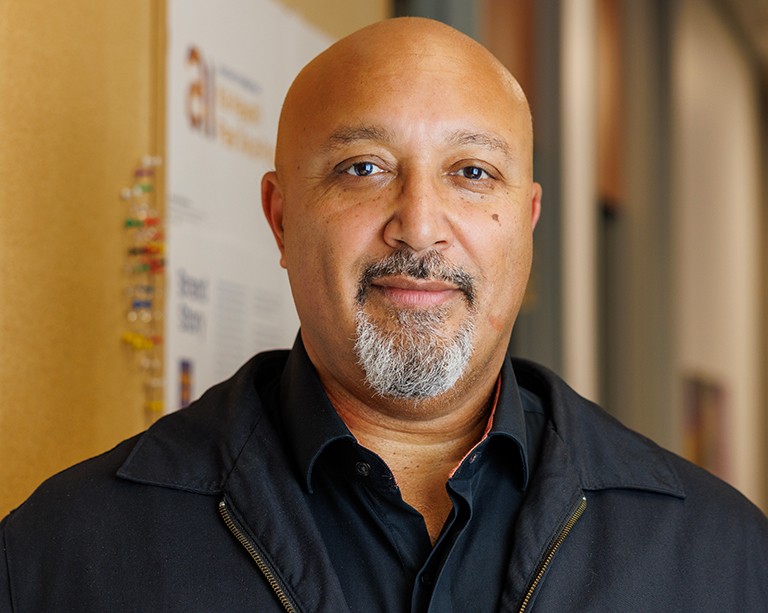‘A pivotal moment for Concordia’

In this message ...
- Update on FY2025-26 budget challenges
- Longtime financial models no longer work
- Faye Diamantoudi appointed executive lead on business development and revenue generation
- Examples of how we can do things differently
- Earning the title of “next-gen university”
History has a way of repeating itself
In the late 1990s, Concordia faced an unprecedented financial crunch. Enrolment had been steadily declining for a decade. Then, the Quebec government slashed university operating budgets by 25 per cent and stopped indexing grants, causing a further loss of 12.5 per cent. The university carried worrisome levels of accumulated debt, up to $40 million by 1997, on an institutional budget far smaller than today. Inevitably, some wondered if Concordia, less than a quarter-century old, could survive.
In that moment of crisis, the university did something remarkable. Our community developed a bold vision for the future, which it pursued with purpose and determination over the decade to follow.
The university took dramatic measures to cut costs and reduce its financial exposure. But it also made calculated investments to differentiate itself and create new capacity for growth.
Taking an intelligent risk, Concordia innovated by issuing $200 million in bonds. It used that capital to construct the Molson and EV buildings and to renovate the Hall Building downtown. It built the Renaud Science Complex and modernized the Bryan and Drummond science buildings at Loyola.
It was also during this period of acute financial stress that the university began to intensify and diversify recruitment activity, making the student body far more cosmopolitan than it had ever been. In the process, Concordia moved decisively beyond the merger phase of its history to streamline units and activities delivered on each campus.
Academically, the university launched path-breaking programs. For example, the Department of Design added Computation Arts in 2001, and the Concordia Institute for Information Systems Engineering was created in 2002 with its exclusive focus on research and graduate training. Through a generous philanthropic donation, the business school launched the Kenneth Woods Portfolio Management Program in 2000, a unique practicum during which students direct millions of dollars of real investments.
To be sure, it was a complicated, sometimes excruciating and uncertain period. But it also set the stage for more than two decades of uninterrupted growth, charting a path that led to Concordia being recognized today as one of the best young universities in the world.
Similar situation, stronger university
Of course, no two historical moments are identical. But for those of us who have been at Concordia long enough, it’s hard not to feel a twinge of déjà vu. Following on the disruptive heels of the pandemic, we’ve been plunged once again into a dire financial situation, primarily because of successive government policies intended to weaken us.
Although we can take some solace from the recent Quebec Superior Court decision in our favour, that victory against unreasonable and unjustified government policies is ultimately a moral, not a material win for Concordia. The damage from those policies has already been done. Furthermore, the negative impact has been compounded by stringent immigration policies that have caused international applications to plummet, weakening the reputation and financial position of universities across Quebec for years to come.
We are at another turning point in Concordia’s history. The difference this time is that we are fundamentally in a far stronger position — with far healthier assets and overall balance sheet at our disposal as well as a much greater reputation — than 25 years ago.
The operating budget for FY2025-26
Yesterday, we presented the university operating budget for Fiscal Year (FY) 2025-26 to our Board of Governors. Consistent with the plan de redressement approved by the Board and the government in December 2023, which aims to restore a balanced budget within five years, this budget sets a final deficit target of $31.6 million for the year ahead. To meet that target, we must achieve some combination of $53 million in savings or new revenues.
If we as a university do nothing, based on our forecasted expenses and anticipated revenues, our deficit will be $84 million. Inevitably, this means we must continue to economize on multiple fronts as we have been doing, including by further lowering our salary costs, curbing activity expenses and reducing services. Because of the measures we have already taken and the sacrifices the community has already made, the range of options we face is tightening. We will therefore need to be even more disciplined as we face harder choices ahead.
Although bittersweet, the encouraging news is that through real sacrifice and a willingness to make difficult decisions across the organization, we have managed to deliver the outcomes expected of us in the first two years of the plan de redressement. These results have been remarkable, considering how dramatically the funding formula and recruitment context were disrupted — that is, how much the rules of the game were changed in the interim.
You can read the full details of the FY2025-26 budget, including what additional cost-reduction measures will be implemented, and updated FAQs on the university’s website.
The pattern of government defunding deepens
Unfortunately, as if the challenges ahead were not daunting enough, the latest Quebec budget has made matters worse.
In FY2025-26, the government will not invest one additional cent into our operations. It also announced grants to universities would be frozen the next year as well. Moreover, for the first time in memory, the government failed to cover the cost of the salary increases negotiated with our unions, even though they are in line with government salary policy. Finally, the government will cease to fund initiatives — in engineering and education, in particular — that amount to roughly $12 million for Concordia.
Yes, you read all that correctly. Notwithstanding ministerial rhetoric to the contrary, when you add it all up, the government is significantly defunding the entire university sector.
Our budgetary challenge is structural
The corrosive year-over-year impact of recent policy decisions means Concordia is now inescapably facing a structural budget deficit. Salary costs, which are far and away our primary expense, continue to grow. By contrast, our student population, the principal source of revenue, is shrinking (by about 700 full-time students in 2024-25). Its profile — by country of origin, academic program and revenue type — is also changing.
Where does this leave us? In the past, we experienced budget challenges when costs grew faster than revenues. However, the challenge we now face is that while costs continue to increase our revenues are falling. In fact, we will generate less income next year than we did this year, a circumstance which is unprecedented in Concordia’s history.
The financial path to mission sustainability
As a university, the core of our mission is to generate and transmit knowledge through teaching and research. Succeeding in this endeavour is paramount and should guide all the decisions we make now and in the future. As such, to ensure the sustainability of our core mission, it has become essential that we chart a new path to financial stability.
To do this, the university needs to develop a novel budget model and longer-term business plan, even as we continue to fulfill the remaining commitments of our plan de redressement, which is required to protect our credit rating and maintain our current borrowing costs.
The budget model that Concordia, like other universities, has traditionally used was predicated on growth in student numbers. We calculated our expenses for the fiscal year ahead and generated revenue to meet those expenses by recruiting new students. Because this growth model no longer holds, we must now invert our approach by identifying our anticipated revenues and aligning our costs accordingly. That will be a major change for our university, requiring a difficult adaptation to a different type of fiscal discipline.
At the same time, we need to transform our business model, becoming less vulnerable to unexpected shifts in government policy. We can do this by continuing to economize and thinking differently about our internal operations and organization while also augmenting our traditional academic programs and research revenues through the pursuit of new opportunities and lines of activity.
To accelerate this last piece, I’ve asked Faye Diamantoudi to take on a new role as executive lead on business development and revenue generation, which she will do alongside her role as dean of Graduate Studies. Working with a small team, Faye will identify new business avenues for the university and collaborate with internal champions to test their viability.
New thinking for new opportunities
We recognize that good ideas can come from anywhere in the university, and examples of Concordia’s evolution can be seen all around us.
The Faculty of Fine Arts is leading the way on transformation as it moves toward integrating the departments of music, dance and theatre into a new School of Performance, which will simultaneously give greater visibility to existing programs, streamline costs, and increase opportunities for students to have enhanced learning experiences through a transdisciplinary approach.
Although still in its infancy, through focus and consolidation, the School of Health is successfully expanding and better targeting its activities. Mainly due to the additional revenues it is generating, the school is costing the university less than the PERFORM Centre did on its own.
In the research sector, the Applied AI and Next-Generation Cities institutes are growing their impact and generating new lines of revenue by deepening collaborations with public and private sector partners. Meanwhile, Volt-Age, in addition to mounting the largest PhD recruitment campaign in the university’s history, is working with the Office of the Vice-President, Research, Innovation and Impact to develop tangible new paths to incubate research commercialization.
One big opportunity for Concordia to pursue flows from the shift in how and when people seek advanced education. While continuing to serve traditional undergraduate and graduate students, we need to recognize that the educational space is rapidly opening-up to meet the needs of new learners — professionals upskilling, international students learning remotely, and partners in different sectors and jurisdictions looking to develop specialized expertise.
Growing out of Concordia’s Africa Initiative, the Gina Cody School in collaboration with the United Nations Development Program’s Tech4Peace initiative and the Give 1 Project, has successfully launched a short, hybrid program of cybersecurity training for youth in West and Central Africa. Following a pilot in 2023, there were more than 20,000 applications for 500 places in the second cohort.
This coming year, we expect to welcome our first undergraduates into Chemical and Materials Engineering (CME). It’s worth remembering that the initial proposal to create CME was made during another period of multi-year deficits when we were operating, as we are now, under a Board- and ministry-approved recovery plan.
In addition to the work done by Continuing Education, initiatives like the School of Health could unlock other opportunities in professional education. Similarly, our recent partnership with Hydro-Québec and Énergir to bring innovative energy solutions to the Loyola Campus as part of PLAN/NET ZERØ has the potential to give Concordia first-mover advantage in creating pedagogy, training and research opportunities in this critical space.
The Loyola project underlines that real estate and infrastructure are among our most important assets, and we need to explore new opportunities to maximize their use as well.
Being proud and determined as a community
These are hard times for higher education, and it is a difficult moment for Concordia. There’s no minimizing that reality.
The whole sector is undergoing a stress test. Many of the financial assumptions that have guided us in the past just aren’t valid anymore. Key sources of funding that we have long counted on have vanished or are no longer dependable.
Thankfully, Concordia is a creative place. And we will need the ingenuity of our community more than ever to develop a compelling vision for what our university can become as we begin the journey beyond our first 50 years.
We have a lot to be proud of when we reflect on how much this university has accomplished in a comparatively short period, almost always against the odds. Concordia will continue to play a big role in the futures of Montreal, Quebec, Canada and the world.
But to fulfill that promise, we need to do more than what we have done well in the past. We need to change, including fundamentally in some key areas, and we need to do so urgently.
For the past 10 years, we’ve characterized Concordia as a next-gen university. Now is the time to make good on that claim.
It won’t be easy. Sometimes it will be disappointing, frustrating and painful. However, the pain will be even more debilitating and chronic if we don’t act now. We — by which I mean our whole community — have no choice but to seize the moment, to be bold, clear-sighted and calculated.
The university has faced adversity before. Together, we will make history repeat itself when we come through stronger this time too.
Graham Carr
President and Vice-Chancellor




